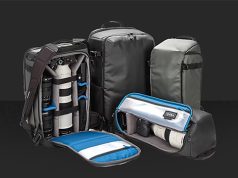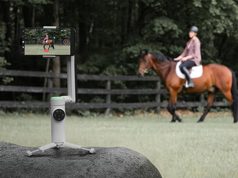
Center Valley, PA—Olympus added to its OM-D family with the E-M10, an interchangeable-lens camera designed to combine the image quality and speed of the flagship Olympus OM-D E-M1 and the OM-D E-M5 into an extremely compact, stylish all-metal body with a more affordable price.
The company also announced the super-slim M.Zuiko Digital 14–42mm f/3.5–5.6 EZ pancake zoom lens and the bright M.Zuiko Digital 25mm f/1.8 lens, expanding its Micro Four Thirds lineup to 15 lenses.
The E-M10 features the TruePic VII image processor (the same one used in the OM-D E-M1), a 16 megapixel Live MOS sensor, Wi-Fi connectivity, a high-speed electronic viewfinder (EVF) and a built-in flash. Its maximum sensitivity of ISO 25,600 permits shooting dark scenes and indoor locations, and ISO low mode (100 equivalent) expands the low-sensitivity end. Olympus says its Fine Detail Processing II technology “configures the appropriate sharpness processing for each individual lens, resulting in natural, high-quality resolution.”
The camera’s in-body three-axis image stabilization system is derived from the five-axis system in the E-M5 and E-M1, counteracting yaw, roll and pitch for still shots and HD movies, regardless of the lens used. Olympus also included its fastest ever AF system, with 81 target areas that cover the whole image. In addition, small AF target and super spot AF modes were added to make it possible to zoom in and focus accurately on minute sections of the frame. The E-M10 is also capable of capturing 8-frames-per-sec sequential shooting; its processor supports continuous capture of 20 RAW frames or an unlimited number of JPEG frames, and the continuous autofocus with tracking mode is said to accurately capture moving subjects at 3.5 fps.
Despite its size, the E-M10 is the first OM-D with a built-in flash that is optimized for 1/250-second synchronization, a benefit for daytime flash photography. Other firsts include live composite mode and photo & movie capture mode. Live composite is a tool that offers previews of long exposures in the EVF; photo & movie capture lets users shoot photos without interrupting video recording.
Additional features include: a 1,440,000-dot EVF with a 120-fps refresh rate, a 100% field of view and max 1.15x magnification; an eye sensor that switches the display between the tilting, 3.0-inch touch-screen monitor and the EVF; the ability to display the effects of exposure adjustments, art filter effects and creative controls like color creator, image aspect control, highlight/shadow control, live histogram, five grid patterns and a level gauge on the EVF; and three HDR capture modes.
The camera also provides built-in Wi-Fi with easy setup for image transfer to a smartphone and then the web. By scanning the QR code displayed on the camera’s LCD with a smart device, it syncs with the Wi-Fi network created by the camera. The free Olympus Image Share app synchronizes a user’s smartphone and E-M10 so the camera’s live view is displayed on the phone and the camera can be controlled by touching the smartphone display as if it were the camera.
New Micro Four Thirds Lenses
Olympus also introduced the M.Zuiko Digital 14–42mm f/3.5–5.6 EZ pancake zoom lens, which measures .9 inch thick. Its electric zoom is suitable for shooting movies and can be zoomed in and out remotely using compatible smartphones through the updated Olympus Image Share app. $349.99.
The new super-bright, lightweight M.Zuiko Digital 25mm f/1.8 lens has a fixed focal length and is geared for capturing portraits or close-ups from as little as 9.8 inches away. $399.99.
New Micro Four Thirds Accessories
New accessories also join the Olympus Micro Four Thirds lineup, including the fixed-aperture f/8.0 fisheye body cap lens with a focal length of 9mm (18mm equivalent) for creative wide-angle shooting. The multiuse lens barrier MF lever switches from pan focus shooting to close-up 8-inch shooting with one press. $99.99.
The ECG-1 matching ergonomic grip is a removable grip exclusively for use with the E-M10. A press of the lever on the bottom of the grip removes it, making replacing batteries and memory cards seamless. $59.99.
The MCON-PO2 macro converter ( $69.99) is compatible with six Olympus Micro Four Thirds lenses and adapts them for close-up shooting, and the automatic-opening lens cap LC-37C is available exclusively for use with the new M.Zuiko Digital ED 14–42mm f/3.5–5.6 EZ. When the camera is turned off, this accessory protects the lens from dust and scratches; when the camera is powered on, the lens cap opens.
The Olympus OM-D E-M10 will be available in March in the following configurations and SRPs: $699.99, body only, available in black and silver; $799.99, body in black or silver with M.Zuiko Digital 14–42mm f/3.5–5.6 II R lens. olympusamerica.com





